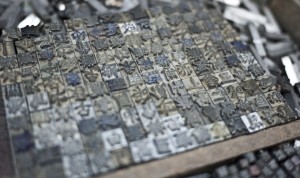During the time of the Late Tang dynasty, Feng Tao, the prime minister, ordered the block printing of the Five Classics. From then on, important public works within China were block printed for distribution to the elite. Bi Sheng would later invent the movable type, which would lead to a revolution in printing. According to The Invention of Moveable Type, the process of utilizing the movable type press required extreme patience and the use of various substances such as turpentine, wax, and burnt paper. The movable type pieces also required extreme patience. Many of the pieces used for printing had to be created on the spot, especially if they were unique characters. Each piece of type had to be carved out of clay, and then fired. Additionally, the pieces of movable type required constant care to keep them functional for future use. Clay type pieces were used instead of wood because they were less likely to become deformed after multiple uses.
An iron plate would be affixed with the aforementioned clay pieces. Once the iron plate was prepared with the various inking substances, the plate would be pressed down on the paper, leaving a clear depiction of the Chinese characters. The clay characters were also very easy to remove from the iron plate. When the characters were not in use, they would be placed on a wooden rack. According to The Invention of the Moveable Type in China, the process of using this press was tedious for hundreds of copies, but when compared to creating thousands of copies, the process seemed efficient. The printing legacy of moveable type would lead to a legacy of printing. Four hundred years later, Johannes Gutenberg would create the printing press, revolutionizing printing and changing the western world forever.



Leave a response